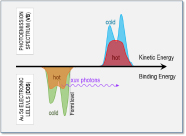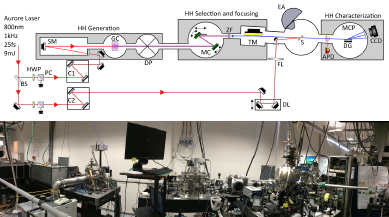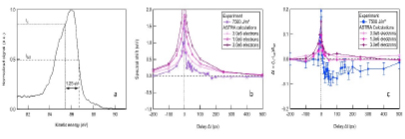Team
- Permanent members: Martino Trassinelli, Christophe Prigent, Emily Lamour, Sébastien Steydli, Stéphane Macé, Dominique Vernhet
The objective of this study is to perform picosecond time-resolved experiments to investigate the ultrafast solid-liquid phase transition induced by infrared (IR) femtosecond (fs) laser pulses in metals. This specific interaction is characterized by the ultrafast energy deposition leading to the creation of an out-of-equilibrium regime of matter defined as a state of matter where the electronic temperature, Te, is different from the lattice one, Tl. In this thermodynamic regime, the matter exhibits specific properties which remain poorly described by theoretical models. This prevents the prediction and control of the following matter relaxation which can suffer structural modifications such as phase transition from solid to liquid or disorder.

Figure 1: Scheme of pump/probe experiments on relaxation dynamics after laser-induced heating.
Probing this regime requires time-resolved diagnostics. We apply a complementary approach to the existing works by using time-resolved photoemission electron spectroscopy (Tr-PES) which should bring information on electronic structure and chemical composition of samples.

Figure 2 : Basic picture of PES diagnostic principle.
Since the valence band is expected to be modified by the change of local atomic order due to the IR laser heating (phase transition, disorder…), this study aims to probe its temporal evolution in the ps range. However, such Tr-PES measurement can suffer an important perturbation due to the presence of photoelectrons emitted by the pump IR beam (charge effect) which is also addressed.
Experimental development and setup
We have built a dedicated HHG xuv beamline (open for external users) delivering probe pulses in the 90 eV spectral range. We have designed this HHG beamline preserving the initial pulse duration of 25 fs in order to access the required temporal resolution. This non-standard HHG beamline have been installed at the CELIA laboratory (Bordeaux, France) taking advantage of the AURORE laser facility delivering 800 nm – 25 fs – 1 kHz laser pulses.

A complete description of the facility is published in Fedorov et al. (Rev. Sci. Instrum., 91 (2020) 105104 – HAL) detailing the following characteristics.
| Plage spectrale | 79 – 95 eV | Flux | 0.2 – 2.6 x 107 photon/s |
| Largeur de bande | ~ 0.9 – 1.2 eV | Durée d’impulsion | 25 fs |
Figure 4: HHG beamline performances.
Tr-PES measurements and interpretation
The objective is to investigate the dynamics of the sample (48 nm thick copper layer deposited on a sapphire substrate) irradiated by an ultrashort laser pulse (1 ps, 6000 to 8200 J.m²). This first study is a proof-of-principle experiment aiming to demonstrate its feasibility. Tr-PES measurements have been analysed to quantify the spectral shift – due to space charges – and distortion – due to space charges and laser heating – of the Cu valence band in order to disentangle the pump-heating from space charge effects. The valence is indeed distorted in our experiment, mainly in a given spectral region, in agreement with what expected for liquid copper.

Figure 5: Tr-PES results recorded on 48 nm Cu sample at 7500 J.m-2 pump laser fluence compared to ASTRA calculations using the Jellium-Volkov model for the input pump parameters: (a) Typical spectrum corresponding to the Cu valence band. (b) Shift of the valence band as a function of the pump/probe delay. (c) Valence shape modification DI = (IX-Iref)/Iref as a function of the pump/probe delay.
The result interpretation is strengthened by a complete space charge modelling based on: (1) a quantum Jellium-Volkov model, that evaluates the probability of the electrons being ejected by the IR pump laser electric field and (2) the ASTRA Particle-In-Cell (PIC) code that accounts for space charge effects during the pump and probe electrons travel up to the detector. Besides these calculations, we have also used the SMILEI PIC code to account for the possible effect of the pump laser electric field on the pump electrons after being ejected from the sample surface. These space charge calculations lead a relatively good agreement with measurements at negative delays, before the laser heating occurs.
Collaborations
- CELIA, Bordeaux, France (J. Gaudin, N. Fedorov, H. Jouin, P. Martin) for the theoretical and experimental support;
- Goethe University, Germany (R. Grisenti)
- Polish Academy of Sciences, Warsaw, Poland;(R. Sobierajski)
- LULI, Palaiseau, France (C. Riconda, S. Marini)
- LCPMR, Paris, France (R. Taieb) for the theoretical support.
.
Thesis
M. De Anda Villa, supervised by D. Vernhet (defended in December 2019) and co-supervised by A. Levy.
.

